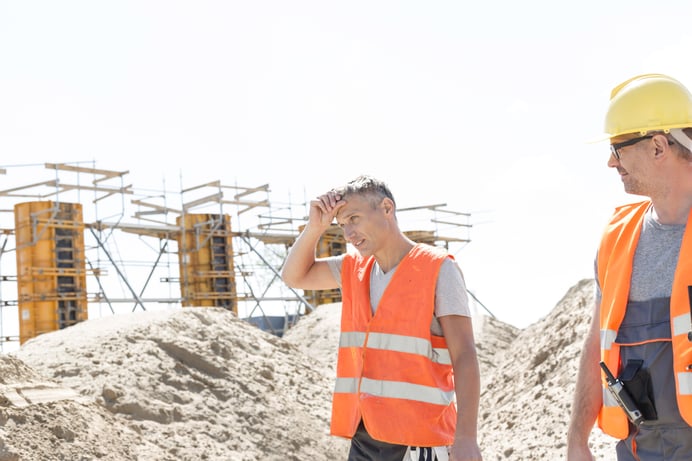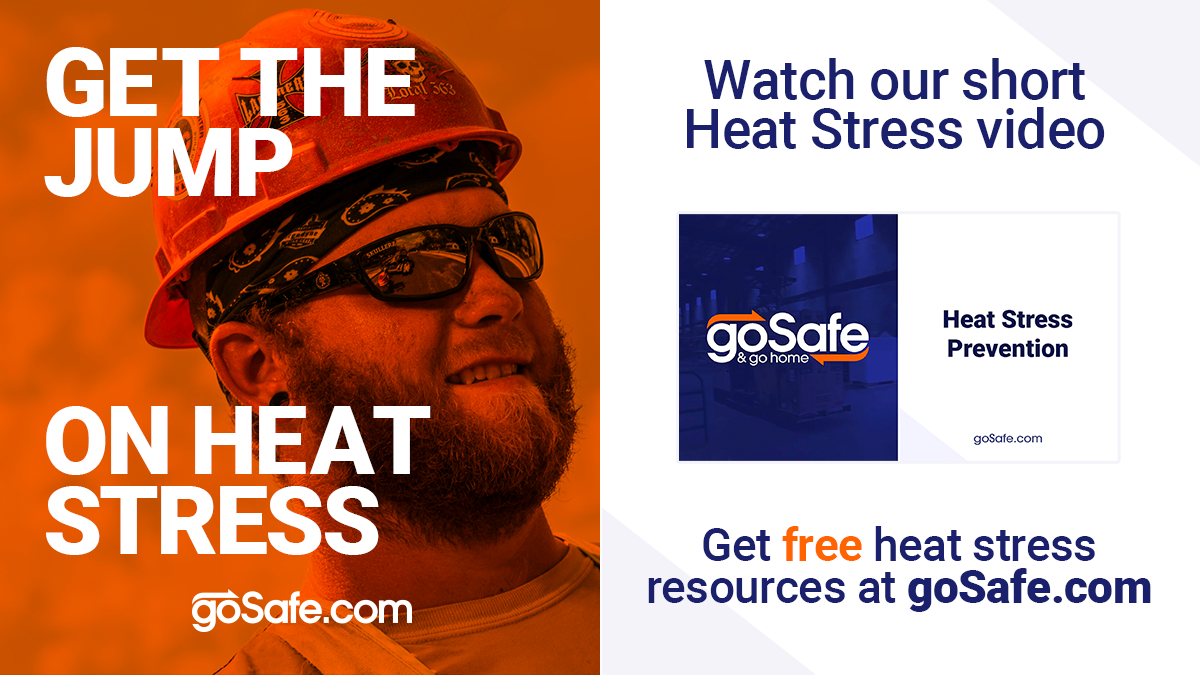
When you think of tents you probably think of camping. But if you think they're only good for the campsite, you're overlooking an important tool to protect employees working in the heat.
The tents might look different on a construction site, but they still provide shelter for workers who need reprieve from the sun and heat of summer. In fact, tents have become significant pieces of construction safety equipment since they often provide the only shade on a job site. As the heat index rises, employers have to consider the health and safety of employees working in extreme temperatures.
The Dangers of Working in the Heat
As the temperature rises, so does the risks of heat exhaustion, heat stroke, and other heat-related injuries, especially for construction workers. Summer is the peak season for construction work but the hot, sunny weather that comes with it brings its fair share of risks.
As global temperatures continue to climb, heat-related deaths are also up. Amid last year’s record-shattering temperature spikes, early estimates from the Centers for Disease Control and Prevention (CDC) indicate that heat deaths jumped 56% between 2018 and 2021, from 1,102 to 1,577. After a rise in heat-related illness fatalities in 2014, the Occupational Safety and Health Administration (OSHA) responded with a Heat Illness Prevention Program targeted at workers who spend most of their days outside in the sun, especially when the heat index is 100 degrees or higher. Their efforts have had a great impact on the number of heat-related illnesses and related deaths.
Working in higher temperatures means the body has to work harder to cool itself, mostly through sweating. If the body can't release enough excess heat, it will begin storing it and cause the body temperature to rise. This is especially dangerous when the humidity levels are higher as the process becomes even more difficult because the sweat does not evaporate fast enough.
Heat-Related Illnesses
The most common heat-related illnesses can occur anytime during the summer but are increasingly dangerous for people who work outdoors, especially those performing strenuous tasks. Construction workers, and other outdoor workers, can experience the following:
- Sunburns result from overexposure to the sun and should be taken seriously as repeated burns can put people at greater risk for skin cancer.
- Heat cramps occur when the body's salt and moisture levels are so low that the muscles contract, causing pain (generally in the abdomen, arms, or legs).
- Heat rash breaks out when sweat ducts are blocked. It is an early warning sign of overheating and usually shows up around the neck, shoulders, and chest but can also affect the armpits, inner elbows, and groin.
- Heat syncope is indicative of heat illness and occurs when the body tries to cool down, the blood vessels dilate, and blood flow to the brain is reduced enough to cause fainting.
- Heat exhaustion is indicated by headache, nausea, dizziness, weakness, thirst, and notable sweating. It should be treated as soon as symptoms present by moving the individual to a shaded area. Cool the affected worker with ice packs and water.
- Heat stroke requires immediate medical attention and is marked by confusion, fainting, seizures, very high body temperatures, and skin that is either very hot and dry or profusely sweating. Heat stroke is the most serious of all heat-related illnesses and you should call 9-1-1 if a worker is showing symptoms.
Thousands of people miss work every year to recover from these illnesses, which has a measurable impact on the company's bottom line. Heat-related illnesses are generally preventable, so why not take the simple steps to avoid the problem altogether?
Heat-Related Illness Prevention
Protecting employees who are working in the heat is crucial, especially as the heat index rises. The good news is that construction site safety equipment has evolved to the point that heat-related illnesses can be prevented with basic gear and proper planning. Be sure that all employees are well-trained on the expectations for summer safety. Provide each team with a construction site safety checklist so there is no confusion. Create procedures for working in the heat.
5-Step Procedure for Working in the heat
- Make sure that employees are dressed properly, wear protective clothing, and have access to shady areas for breaks.
- Encourage workers to take plenty of breaks to re-hydrate and make sure plenty of cool water is available.
- Sunscreen should be applied every two hours if you are sweating. It is best to use sunscreen with an SPF 30 or higher—and don’t forget to protect the lips!
- Plan tasks according to daily temperatures, set the most strenuous jobs for the coolest times of day. It takes the body time to adjust to extreme temperatures so allow for extra breaks the first week or two of hot weather.
- Provide proper first aid training and offer refreshers. Remind employees to monitor each other for signs of illness.
All workers should be aware of the symptoms of heat-related illnesses and be reminded to look out for each other. Emergency plans should be well-defined and everybody should know who to contact in case of a heat-related emergency. Quick response to heat-related illness is crucial.
Provide Complete Cooling Stations
In the heat of summer, creating cooling stations can help prevent heat-related illnesses. Providing shade, good air flow, and cool water is the winning combination when it comes to construction site safety. Follow these tips for creating your team’s cooling stations:
- Tents provide shade and protection from the sun’s harmful rays and can lower heat indexes by up to 15 degrees Fahrenheit. Taking a break in the shade allows workers to reapply sunscreen to prevent burns
- Take your tent set-up a step further and add fans to help cool your workers. Fans compensate when there is a lack of airflow (no breeze). Some fans also blow a mist that can help lower body temperature
- Hydration stations are a must on worksites and should be stocked with plenty of cool water
When the body becomes overheated and can't cool itself, shade and water are essential to alleviate and prevent the worsening of heat-related symptoms. Cooling stations are preventative measures but they can also provide for a quick response in case there is a heat-related emergency on a work site. Not sure if electrolytes matter? Check out our blog "Do Your Employees Really Need Electrolytes?" to learn more.
Incentive to Break and Re-hydrate
But what about those workaholic employees who don’t want to stop until the job is done?!
Drinking water every fifteen minutes—even when you’re not thirsty—is one of the most important steps in preventing heat-related illnesses but some workers prefer to power through and complete the task at hand.
Providing incentives like the shade of a tent and cool water is a great way to encourage even your hardest working employees to stop and re-hydrate regularly. Even the most committed worker would have a tough time turning down a little time to kick off their heavy gear and enjoy a cool drink in the shade.
Summer Safety is Essential
Temperatures are on the rise as summer sets in and as heat indexes hit 100 degrees, the likelihood of heat-related illness rises considerably. There’s no benefit to employees missing work to recover from heat-related illnesses when they are preventable. Providing something as simple as shade under a tent and making regular breaks a part of the worksite culture shows employees that you care about their well-being, which can improve employee loyalty and commitment to the job.
Let’s get our workers home safe and keep them healthy!








